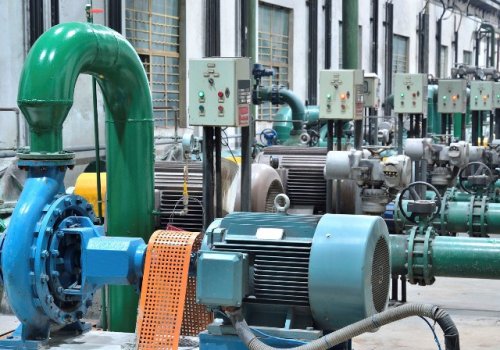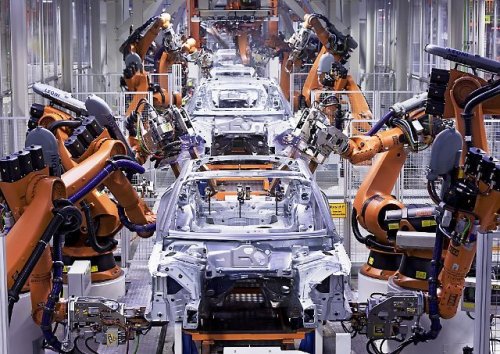What is feedback in electronics and automation
Feedback is the effect of the output value of each system C (Fig. 1) on the input of the same system. Wider feedback — the influence of the results of the functioning of the system on the nature of this functioning.
In addition to the amount of output, external influences can also act on a functioning system (x in Fig. 1). The AV circuit through which the feedback is transmitted is called a feedback loop, line, or channel.
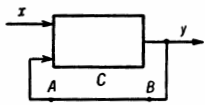
Rice. 1.
The channel itself can contain any system (D, Fig. 2) that transforms the output value in the process of its transmission. In this case, the feedback from the system's output to its input is said to occur using or through the D system.
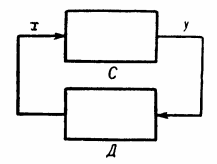
Rice. 2.
Feedback is one of the most important concepts in electronics and automatic control theory. Concrete examples of the implementation of systems containing feedback can be found in the study of a wide variety of processes in automatic systems, living organisms, economic structures, etc.
Due to the universality of the concept, applicable in various fields of science and technology, the terminology in this field is not established, and each specific field of knowledge, as a rule, uses its own terminology.
For example, in automatic control systems widely used concepts of negative and positive feedback, which define the connection between the output of the system and its input through a gain connection with a corresponding negative or positive gain.
In the theory of electronic amplifiers, the meaning of these terms is different: feedback is called negative, which reduces the absolute value of the overall gain, and positive - increases it.
Depending on the implementation methods in the theory of electronic amplifiers exist current, voltage and combined feedbacks.
Automatic control systems often include additional reviewsused to stabilize systems or improve transients in them. They are sometimes called corrective and among them there are hard (performed using a booster connection), flexible (implemented by differentiating relation), isodromic etc.
In different systems you can always find closed chain of influence… For example, in fig. 2, part B of the system acts on part D, and the latter again on C. Therefore, such systems are also called closed-loop systems, closed-loop or closed-loop systems.
In complex systems, many different feedback loops can exist. In a multi-element system, the output of each element can, generally speaking, affect the inputs of all other elements, including its own input.
Each impact can be considered from three main aspects: metabolic, energetic and informational. The first is related to changes in the location, shape and composition of matter, the second to the transfer and transformation of energy, and the third to the transmission and transformation of information.
In control theory, only the informational side of influences is considered. Thus, feedback can be defined as passing information about the output value of the system to its input or as the arrival of information converted by the feedback link from the output to the input of the system.
The principle of the device is based on the application of feedback. automatic control systems (ACS)… In them, the presence of feedback provides an increase in noise immunity due to a reduction in the influence of interference (z in Fig. 3) acting in the front part of the system.
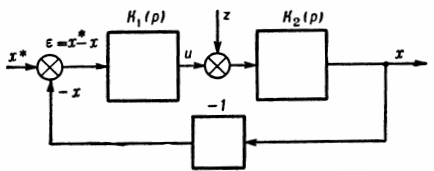
Rice. 3.
If in a linear system with connections with transfer functions Kx (p) and K2 (p) you remove the feedback loop, then the image x of the output value x is determined by the following relationship:

If in this case the output value x is required to be exactly equal to the reference action x *, then the total gain of the system K (p) = K1 (p) K2 (p) must be equal to unity and there must be no interference z. The presence of z and the deviation of K (p) from unity give rise to an error e, i.e. the difference

For K (p) = 1 we have

If we now close the system using feedback as shown in Fig. 3, the image of the output quantity x will be determined by the following relationship:

It follows from the relation that for a sufficiently large gain module Kx (p), the second term is negligible and therefore the influence of the interference z is negligible. At the same time, the value of the output quantity x will differ very little from the value of the reference variable.
In a closed system with feedback, it is possible to significantly reduce the influence of noise compared to an open system, since the latter does not respond to the actual state of the controlled object, is "blind" and "deaf" «until a change in this state.
Let's take an airplane flight as an example. If the plane's rudders are pre-adjusted with high precision so that it flies in a certain direction, and if they are fixed rigidly, then gusts of wind and other random and unforeseen factors will knock the plane off the desired course.
Only the feedback system (autopilot) is able to correct the position, which is able to compare the given course x * with the actual x and, depending on the resulting deviation, change the rudder position.
Feedback systems are often said to be error-driven (discrepancy). If the link Kx (p) is an amplifier with a sufficiently large gain, then under certain conditions imposed on the transfer function K2 (p) the rest of the way, the closed-loop system remains stable.
In this case, the steady-state error e can be arbitrarily small. It is enough that it appears at the input of the amplifier Kx (p) so that a sufficiently large voltage is formed and is formed at its output, which automatically compensates for interference and provides such a value of x at which the difference e= x * — x would be small enough.The smallest increase in e causes a disproportionately larger increase in ti... Therefore, any (within practical limits) interference z can be compensated for, and furthermore, with an arbitrarily small value of the error e, the high-gain maneuvering path is often called deep.
Feedback in mixed systems also takes place during the functioning of complex systems consisting of objects of different nature, but acting purposefully. These are systems: operator (human) and machine, teacher and student, lecturer and audience, human and learning device.
In all these examples we are dealing with a closed chain of influences. Through the feedback channels, the operator receives information about the nature of the functioning of the controlled machine, the trainer - information about the behavior of the student and the results of training, etc. In all these cases, in the process of functioning, both the content of the information transmitted through the channels, and the channels themselves change significantly.

